Hello - this is my first post so before I get to the meat of things here's a quick summary of how I got here...
I've always been a bit of a gamer, starting out with dice and pencil games like D&D, over time this evolved into on-line gaming. In parallel I've also pursued a geeky career in Engineering in the embedded SW space.
Up until last year I'd mainly played games on a laptop but I became increasingly frustrated with the compromised performance of laptops so I decided to put some time and money into building a gaming rig.
The initial build was air cooled and even then largely beat my expectations in terms of what I could achieve.
BUT, what I quickly recognised was that I enjoyed the building and the tinkering with the rig more than I actually enjoyed playing games on it - So, it's largely been a constantly evolving beast since then!
Earlier this year I kind of ran out of things to do with the air-cooled setup so I decided to jump in and convert it to water cooled - which was a level of fun beyond the initial build and now I'm fully hooked.
So in summary I've been interested in water cooling for 2-3 months; I've got my rig to a point which is both (to me at least) aesthetically pleasing and somewhat performant; but based on what I've read I think my current setup isn't properly dimensioned for the heat being generated... so I'm here looking for a bit of advise from you seasoned experts and enthusiasts!
Let me start with some statements/assumptions to sketch out why I think the system isn't dimensioned properly and why I think the problem is with the dimensioning and not something like a botched application of heat paste:
1/ I believe that the key metric in understanding how effective the system is is dT at load = the delta between ambient temp and the temp of the system under load.
-- What isn't 100% clear to me is exactly which temperatures you measure to determine this - my *assumption* is that it should be the coolant in the system and that the ambient is the temperature with nothing running, i.e. the coolant is effectively at a temperature very similar to the air temp in the room.
-- Based on that my ambient is ~20degC and maxes out at ~40degC after a 2-3 hours of gaming on ultra graphics settings, making the dT 20degC.
2/ My *assumption* is that in order to raise the temperature in this way the transfer of heat between the different cores and the coolant must be reasonably efficient so my conclusion is that the issue is with how I dump that heat out of the coolant, hence why I believe that the system isn't properly dimensioned.
Some other observations:
3/ It seems to me that the biggest contributing factor to generating the heat is the GPU's (2 x GTX970's in parallel), at least when I stress the CPU (i5 6600K) with Prime95, even if I OC it to 4.7GHz, the dT is in the range of 5-7degC (I don't recall exactly), but when I run benchmarks that stress the GPU's the dT can run to 10-15degC (depending on the benchmark).
4/ Even when the coolant temp is at ~40degC I don't feel that the air being exhausted by the system is particularly warm which reinforces my feeling that the system isn't able to dump the heat effectively.
5/ My quick and dirty calculation is that the whole system must be generating somewhere in the region of 650TDP (~100 for the CPU + 2 x 250 for the GPU's + something for the pump + some mystery fudge factor)
Here are a couple of pictures so you get a feel for what it looks like today:


And here is a diagram to show the current configuration:

Please note:
- The use of the "industrial spec" Noctua fans internally is more for the asthetics - I much prefer the black over the default colour, especially with the addition of the red corner rubbers.
- The upper most of the two fans on the inner partition wall is almost purely there again for asthetics - there's no space behind it to mount a radiator but neither did I want to have an open gap exposing some of the ugliness behind.
Given the limited space that I have to play with the conclusions that I've drawn as to how I improve the capacity of the system to dump heat is as follows:
A. Swap out the Alphacool 8fpi rad with a Black Ice 16fpi fan (same-ish thickness).
B. Swap out the "standard" Noctua's on the top with "industrial" Noctua's for the extra airflow and extra static pressure.
C. Swap out the ST30 140 rad for an UT60 140 rad and add an extra fan for push-pull on that rad.
(worth noting that I'm prepared for the system being a little noiser - but at the same time I'm also assuming that the noise won't be too bad because the fans still push/pull a lot through even at low revs)
Hopefully all that makes sense - please tell me if it doesn't - but this is where I'm getting hung up... I know where I want to locate my fans but I can't make my mind up how to orientate them...the apparently age old conundrum of positive-v-negative pressure woven together with the conundrum of using rad-fans as intake-v-exhaust...
In short I've come up with two options as illustrated below:

Pro: better balanced airflow (2 intakes and 3 exhausts)
Con: air through the top fans is already heated

Pro: air through both rads is coming from outside the case so should be cooler
Con: airflow is badly balanced (4 intakes and 1 exhaust)
If you've got this far, thanks for sticking with me...
... now, what do you reckon:
- Do my assumptions make sense?
- Does my conclusion about the cause of the problem make sense?
- Will the changes to the fans and rads improve the situation in an appreciable way e.g. any change to get dT down to ~10degC rather than ~20degC? (assuming I'm even calculating this right!)
- What are your thought on Option A vs Option B?
- Other thoughts?
Thanks Again.
Raz.
I've always been a bit of a gamer, starting out with dice and pencil games like D&D, over time this evolved into on-line gaming. In parallel I've also pursued a geeky career in Engineering in the embedded SW space.
Up until last year I'd mainly played games on a laptop but I became increasingly frustrated with the compromised performance of laptops so I decided to put some time and money into building a gaming rig.
The initial build was air cooled and even then largely beat my expectations in terms of what I could achieve.
BUT, what I quickly recognised was that I enjoyed the building and the tinkering with the rig more than I actually enjoyed playing games on it - So, it's largely been a constantly evolving beast since then!
Earlier this year I kind of ran out of things to do with the air-cooled setup so I decided to jump in and convert it to water cooled - which was a level of fun beyond the initial build and now I'm fully hooked.
So in summary I've been interested in water cooling for 2-3 months; I've got my rig to a point which is both (to me at least) aesthetically pleasing and somewhat performant; but based on what I've read I think my current setup isn't properly dimensioned for the heat being generated... so I'm here looking for a bit of advise from you seasoned experts and enthusiasts!
Let me start with some statements/assumptions to sketch out why I think the system isn't dimensioned properly and why I think the problem is with the dimensioning and not something like a botched application of heat paste:
1/ I believe that the key metric in understanding how effective the system is is dT at load = the delta between ambient temp and the temp of the system under load.
-- What isn't 100% clear to me is exactly which temperatures you measure to determine this - my *assumption* is that it should be the coolant in the system and that the ambient is the temperature with nothing running, i.e. the coolant is effectively at a temperature very similar to the air temp in the room.
-- Based on that my ambient is ~20degC and maxes out at ~40degC after a 2-3 hours of gaming on ultra graphics settings, making the dT 20degC.
2/ My *assumption* is that in order to raise the temperature in this way the transfer of heat between the different cores and the coolant must be reasonably efficient so my conclusion is that the issue is with how I dump that heat out of the coolant, hence why I believe that the system isn't properly dimensioned.
Some other observations:
3/ It seems to me that the biggest contributing factor to generating the heat is the GPU's (2 x GTX970's in parallel), at least when I stress the CPU (i5 6600K) with Prime95, even if I OC it to 4.7GHz, the dT is in the range of 5-7degC (I don't recall exactly), but when I run benchmarks that stress the GPU's the dT can run to 10-15degC (depending on the benchmark).
4/ Even when the coolant temp is at ~40degC I don't feel that the air being exhausted by the system is particularly warm which reinforces my feeling that the system isn't able to dump the heat effectively.
5/ My quick and dirty calculation is that the whole system must be generating somewhere in the region of 650TDP (~100 for the CPU + 2 x 250 for the GPU's + something for the pump + some mystery fudge factor)
Here are a couple of pictures so you get a feel for what it looks like today:
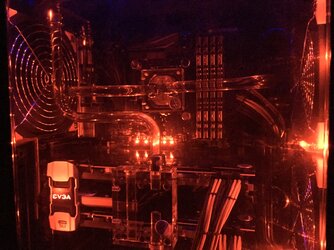
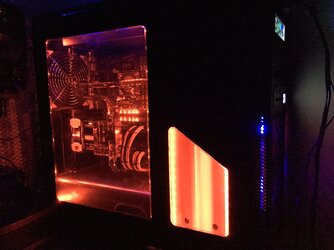
And here is a diagram to show the current configuration:
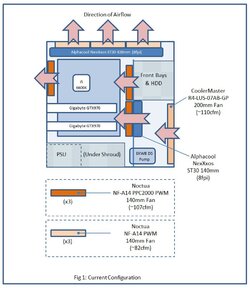
Please note:
- The use of the "industrial spec" Noctua fans internally is more for the asthetics - I much prefer the black over the default colour, especially with the addition of the red corner rubbers.
- The upper most of the two fans on the inner partition wall is almost purely there again for asthetics - there's no space behind it to mount a radiator but neither did I want to have an open gap exposing some of the ugliness behind.
Given the limited space that I have to play with the conclusions that I've drawn as to how I improve the capacity of the system to dump heat is as follows:
A. Swap out the Alphacool 8fpi rad with a Black Ice 16fpi fan (same-ish thickness).
B. Swap out the "standard" Noctua's on the top with "industrial" Noctua's for the extra airflow and extra static pressure.
C. Swap out the ST30 140 rad for an UT60 140 rad and add an extra fan for push-pull on that rad.
(worth noting that I'm prepared for the system being a little noiser - but at the same time I'm also assuming that the noise won't be too bad because the fans still push/pull a lot through even at low revs)
Hopefully all that makes sense - please tell me if it doesn't - but this is where I'm getting hung up... I know where I want to locate my fans but I can't make my mind up how to orientate them...the apparently age old conundrum of positive-v-negative pressure woven together with the conundrum of using rad-fans as intake-v-exhaust...
In short I've come up with two options as illustrated below:
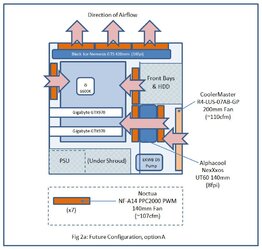
Pro: better balanced airflow (2 intakes and 3 exhausts)
Con: air through the top fans is already heated
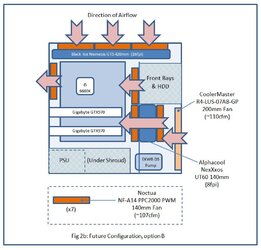
Pro: air through both rads is coming from outside the case so should be cooler
Con: airflow is badly balanced (4 intakes and 1 exhaust)
If you've got this far, thanks for sticking with me...
... now, what do you reckon:
- Do my assumptions make sense?
- Does my conclusion about the cause of the problem make sense?
- Will the changes to the fans and rads improve the situation in an appreciable way e.g. any change to get dT down to ~10degC rather than ~20degC? (assuming I'm even calculating this right!)
- What are your thought on Option A vs Option B?
- Other thoughts?
Thanks Again.
Raz.
Last edited: